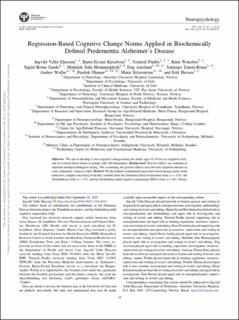| dc.contributor.author | Eliassen, Ingvild Vøllo | |
| dc.contributor.author | Kirsebom, Bjørn-Eivind | |
| dc.contributor.author | Fladby, Tormod | |
| dc.contributor.author | Waterloo, Knut | |
| dc.contributor.author | Sando, Sigrid Botne | |
| dc.contributor.author | Hemminghyth, Mathilde Suhr | |
| dc.contributor.author | Aarsland, Dag | |
| dc.contributor.author | Reina, Santiago Timon | |
| dc.contributor.author | Wallin, Anders | |
| dc.contributor.author | Öhman, Fredrik | |
| dc.contributor.author | Eckerström, Marie | |
| dc.contributor.author | Hessen, Erik | |
| dc.date.accessioned | 2023-01-13T10:14:30Z | |
| dc.date.available | 2023-01-13T10:14:30Z | |
| dc.date.created | 2022-11-01T12:27:24Z | |
| dc.date.issued | 2022 | |
| dc.identifier.citation | Neuropsychology. 2022, 37 (1), 32-43. | en_US |
| dc.identifier.issn | 0894-4105 | |
| dc.identifier.uri | https://hdl.handle.net/11250/3043303 | |
| dc.description.abstract | Objective: We aim to develop 2-year cognitive change norms for adults ages 41–84 for six cognitive tests, and to evaluate these norms in groups with AD biomarkers. Background: Practice effects are common in repeated neuropsychological testing. Not accounting for practice effects may obscure cognitive decline in early Alzheimer’s disease (AD). Method: We developed standardized regression-based change norms from normative samples consisting of healthy controls from the Dementia Disease Initiation study (n = 125), the Trønderbrain study (n = 57), and the Gothenburg mild cognitive impairment (MCI) study (n = 65). Norms were applied in a sample with cognitive symptoms (subjective cognitive decline or MCI) and AD cerebrospinal fluid (CSF) biomarkers (n = 246), classified according to the A/T/N system. Results: The change norms adjusted for pertinent demographics and practice effects. The group with cognitive complaints displayed a trend toward cognitive decline compared to the normative group, with the A+T/N+ subgroup showing the most marked decline. This was observed in tests of episodic memory and cognitive flexibility/divided attention. Conclusions: We present 2-year cognitive change norms for adults between 41 and 84 years, adjusted for practice and demographics. A web-based change norm calculator is provided. | en_US |
| dc.language.iso | eng | en_US |
| dc.publisher | American Psychological Association | en_US |
| dc.rights | Navngivelse 4.0 Internasjonal | * |
| dc.rights.uri | http://creativecommons.org/licenses/by/4.0/deed.no | * |
| dc.title | Regression-Based Cognitive Change Norms Applied in Biochemically Defined Predementia Alzheimer’s Disease | en_US |
| dc.title.alternative | Regression-Based Cognitive Change Norms Applied in Biochemically Defined Predementia Alzheimer’s Disease | en_US |
| dc.type | Peer reviewed | en_US |
| dc.type | Journal article | en_US |
| dc.description.version | publishedVersion | en_US |
| dc.source.pagenumber | 32-43 | en_US |
| dc.source.volume | 37 | en_US |
| dc.source.journal | Neuropsychology | en_US |
| dc.source.issue | 1 | en_US |
| dc.identifier.doi | 10.1037/neu0000853 | |
| dc.identifier.cristin | 2067323 | |
| cristin.ispublished | true | |
| cristin.fulltext | original | |
| cristin.qualitycode | 2 | |

